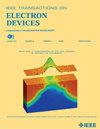Investigation of the Modulated Threshold Memristor for Tunable Artificial Neuron
IF 2.9
2区 工程技术
Q2 ENGINEERING, ELECTRICAL & ELECTRONIC
引用次数: 0
Abstract
Threshold switching (TS) memristor with a simple structure and high biomimetic offers a more promising way to implement an efficient artificial neuron than traditional methods. To accommodate the complex environments in practical applications, previous memristor-based neurons typically incorporate auxiliary circuits to ensure tunability within circuits. However, this addition not only heightens the design complexity but also reduces the efficiency. In this work, we investigate the conduction process under different thresholds in an NbOx-based memristor and further demonstrate its potential merits in human face recognition. The negative threshold voltage of the device can be linearly modulated by positive stimuli. The conduction mechanisms under different threshold states are systematically investigated by experiments and theoretical analysis, showing that the defects concentration controlled by the electrical field is attributed to the threshold modulation. The revealed mechanism is instructive for device optimization, offering an oxygen-related fabrication method. Based on such a device, we construct a tunable spiking neuron whose threshold can be modulated by only one preoperation on the neuron without other burdensome units. By modulating the threshold based on the light intensities—a lower threshold for the bright condition and a higher threshold for the dark condition—the temporal features of the neuron outputs can be maintained at a normal condition to ensure the correct recognition under different environmental luminance. The function of the proposed tunable neuron is further evaluated in a network for human face recognition. The network finally reaches a 93.25% accuracy with tunable threshold neurons, significantly surpassing the 71.87% with fixed-threshold neurons.用于可调人工神经元的调制阈值记忆晶体管研究
阈值开关(TS)忆阻器结构简单,生物仿真度高,与传统方法相比,它为实现高效人工神经元提供了一种更有前景的方法。为了适应实际应用中的复杂环境,以往基于忆阻器的神经元通常会加入辅助电路,以确保电路内部的可调谐性。然而,这种添加不仅增加了设计的复杂性,也降低了效率。在这项工作中,我们研究了基于氧化铌的忆阻器在不同阈值下的传导过程,并进一步证明了它在人脸识别方面的潜在优势。该器件的负阈值电压可通过正刺激线性调节。实验和理论分析系统地研究了不同阈值状态下的传导机制,表明电场控制的缺陷浓度是阈值调制的原因。所揭示的机制对器件优化具有指导意义,提供了一种与氧相关的制造方法。在这种器件的基础上,我们构建了一种可调尖峰神经元,其阈值只需对神经元进行一次预操作即可调制,而无需其他繁琐的单元。通过根据光照强度调节阈值--在明亮条件下降低阈值,在黑暗条件下提高阈值--神经元输出的时间特征可以保持在正常状态,从而确保在不同环境亮度下的正确识别。我们在人脸识别网络中进一步评估了所提出的可调神经元的功能。使用可调阈值神经元的网络最终达到了 93.25% 的准确率,大大超过了使用固定阈值神经元的 71.87% 的准确率。
本文章由计算机程序翻译,如有差异,请以英文原文为准。
求助全文
约1分钟内获得全文
求助全文
来源期刊

IEEE Transactions on Electron Devices
工程技术-工程:电子与电气
CiteScore
5.80
自引率
16.10%
发文量
937
审稿时长
3.8 months
期刊介绍:
IEEE Transactions on Electron Devices publishes original and significant contributions relating to the theory, modeling, design, performance and reliability of electron and ion integrated circuit devices and interconnects, involving insulators, metals, organic materials, micro-plasmas, semiconductors, quantum-effect structures, vacuum devices, and emerging materials with applications in bioelectronics, biomedical electronics, computation, communications, displays, microelectromechanics, imaging, micro-actuators, nanoelectronics, optoelectronics, photovoltaics, power ICs and micro-sensors. Tutorial and review papers on these subjects are also published and occasional special issues appear to present a collection of papers which treat particular areas in more depth and breadth.
 求助内容:
求助内容: 应助结果提醒方式:
应助结果提醒方式:


